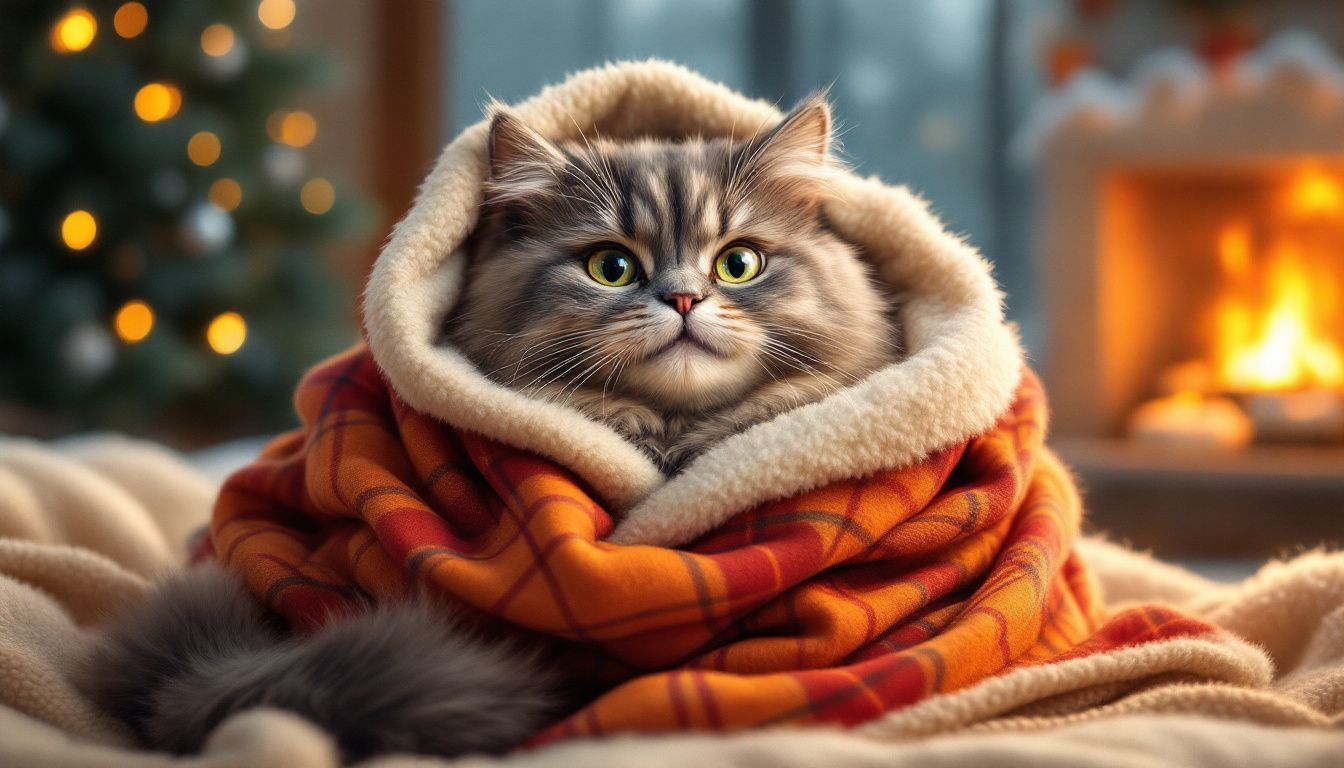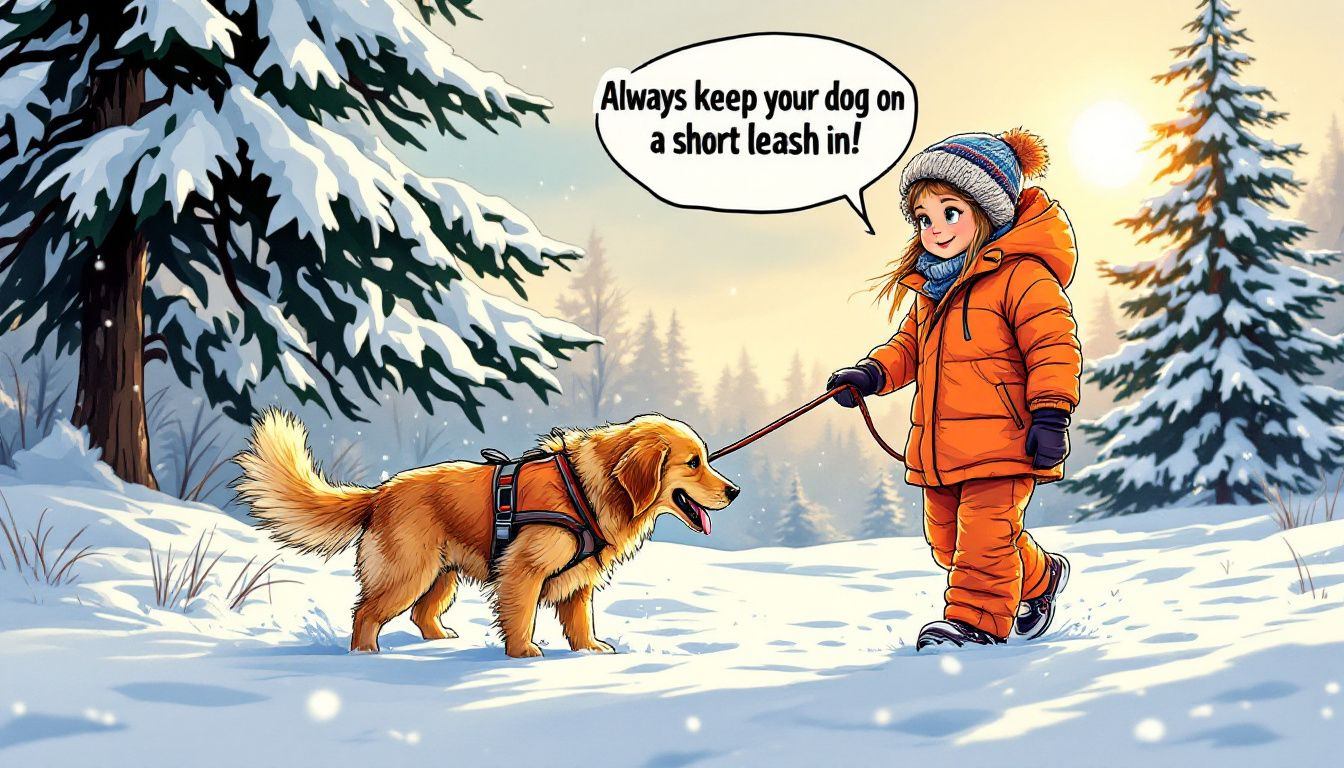Worried about your pets in winter? Here are 10 winter pet safety tips to keep them warm and safe from cold weather hazards. Find out how to protect your furry friends this season.
Key Takeaways
-
Keep pets indoors during extreme cold to avoid serious health risks like hypothermia.
-
Protect your pet’s paws from harsh winter conditions with booties or petroleum jelly to prevent irritation.
-
Adjust your pet’s diet and provide extra warmth through coats and blankets to support their health in winter.
1) Keep Your Pets Inside During Extreme Cold

Leaving pets outside during extreme cold can have severe consequences. Pets exposed to cold weather risk freezing, disorientation, and even potential death. The bitter cold can be unforgiving, and our pets rely on us to keep them safe. Bring pets inside during cold spells to prevent them from suffering.
Signs of hypothermia in pets include shivering, stiffness, and pale gums, indicating that immediate action is necessary. If these symptoms appear, bring your pet inside and wrap them in warm materials to help raise their body temperature. In severe cases, where pets are unresponsive or have slow breathing, seek immediate veterinary care.
Pet owners must understand the risks of leaving pets outside in extreme cold. Providing a warm place for your pets indoors can make all the difference in their health and well-being. Don’t leave pets outside; bring them in and provide them with the warmth and safety they need to thrive during winter.
Additionally, always check the weather forecast and plan accordingly. If you know a cold front is approaching, make arrangements to keep your pets inside and comfortable. Taking these precautions helps keep your pets warm and safe throughout the winter months.
2) Protect Your Pet's Paw Pads
Cold weather can be particularly harsh on your pet’s paw pads. Ice melts, chemicals, and salt can cause irritation and even injuries. Dog booties shield paws from harmful elements and provide a protective layer. If booties are not an option, applying a layer of petroleum jelly on their paws before walks can also create a protective barrier against salt and chemicals.
Regularly check your pet’s paw pads during winter. After walks, inspect their paws for any signs of damage or irritation caused by cold weather elements. Moisturizing the areas between your pet’s paw pads can prevent dryness and irritation, keeping their feet comfortable and healthy.
Protecting your pet’s feet and paw pads is a vital part of winter pet safety. Ensuring their feet are protected and checking for signs of irritation helps pets enjoy winter walks without discomfort or injury.
3) Provide Extra Warmth with Coats and Blankets

Just like us, our pets need extra warmth during the cold winter months. Short-haired breeds, such as Greyhounds and Bulldogs, are particularly vulnerable to the cold and require additional warmth. A well-fitted winter coat that covers the back from neck to tail can provide the necessary insulation to keep them warm.
Make sure the coat fits properly, securely wrapping around your dog’s belly without being too loose or tight. Heavier coats are essential when temperatures dip below freezing, as they offer better protection against severe weather. A warm blanket in a cozy place to sleep can make a big difference in keeping your pet comfortable during cold nights.
Providing your pets with the appropriate coats and blankets ensures they stay warm and comfortable throughout the winter. Remember, pets should not wear coats indoors to prevent overheating.
4) Ensure Proper Nutrition for Winter Months
Winter months require pets to expend extra energy to stay warm. Therefore, it’s essential to adjust their diet to meet these increased energy needs. Feeding your pets a little extra during the winter can help them maintain their body heat and stay warm. However, if you notice your pet gaining weight, consult a veterinarian about a lower-calorie diet to ensure they remain healthy.
For short-haired dogs, using a coat or sweater is essential to keep them warm. These additional layers can help conserve energy that would otherwise be used to maintain body temperature. A dog winter coat that blocks the wind is particularly useful for dogs that spend extended periods outdoors during winter.
Proper nutrition and using coats and sweaters are key components of winter pet safety. These adjustments help your pets stay warm and healthy throughout the cold weather.
5) Safe Walks in Winter Weather

Winter weather can pose unique challenges during walks. Ensuring your pet is visible in dim light is crucial for their safety. Using reflective gear and light-up collars can significantly improve visibility, making your pet more noticeable to others. High-visibility collars and jackets are also great options to enhance their safety during low-light conditions.
Keeping your dog leashed during winter walks prevents accidents on icy surfaces. Slipping and falling can cause injuries, so it’s important to maintain control and avoid potential hazards. Attachable safety lights can further enhance visibility, ensuring your pet is easily seen in darker environments.
Following these winter pet safety tips ensures that your winter walks are enjoyable and safe for both you and your pet. These precautions help keep your pets safe, even during the coldest months of the year.
6) Prevent Dry Skin and Irritated Paws
Winter weather can lead to dry skin and irritated paws for your pets. Towel drying your pets after they’ve been outside can help prevent dryness and irritation. Drying their feet and stomach after winter walks keeps them comfortable and reduces the risk of dry skin.
Regular inspection of your dog’s paws is essential to identify signs of irritation or injury early. Excessive exposure to salt can lead to dryness, cracking, or burning of a dog’s paw pads. Moisturizing these areas can help prevent these issues and keep your pet’s feet healthy.
These steps help prevent dry skin and irritated paws, ensuring your pet stays comfortable throughout the winter months.
7) Avoid Toxic Chemicals
Winter brings the risk of exposure to toxic chemicals, such as antifreeze. Antifreeze contains ethylene glycol, which has a sweet taste that attracts pets but is extremely harmful and can be fatal. As little as a teaspoon can be lethal to a cat. Use propylene glycol-based antifreeze, which is safer, though not completely risk-free.
Immediate clean-up of any antifreeze spills is crucial to prevent pet exposure. Additionally, storing antifreeze in secure containers can help prevent accidental ingestion by pets.
These precautions help avoid the dangers of toxic chemicals and keep your pets safe during the winter months.
8) Limit Bathing During Cold Spells
Frequent bathing during winter can strip pets of their natural oils, causing dry and irritated skin and flaking skin. To prevent this, it’s recommended to minimize the frequency of pet baths during cold spells. Using room temperature water can cleanse effectively without causing excessive dryness.
Limiting baths and using appropriate water temperatures helps maintain your pet’s skin health and prevent dryness during the winter months.
9) Create a Warm Shelter for Outdoor Pets

For pets left outdoors, creating a warm shelter is essential for their safety and comfort. A dry, draft-free shelter that retains body heat is essential. Insulated shelters help maintain warmth and protect pets from harsh winter winds. The entrance of the shelter should be small to minimize wind exposure.
Elevated shelters allow for better drainage and keep pets dry in snowy conditions. Using straw as bedding can provide additional insulation for outdoor pet shelters. Regularly check and maintain the shelter to ensure it remains safe and comfortable.
Providing a warm shelter ensures your outdoor furry friends stay safe and comfortable throughout the winter weather.
10) Monitor for Signs of Discomfort
Monitor your pets for signs of discomfort during winter. Be aware of your pet’s cold tolerance, and make adjustments based on individual needs. Signs of hypothermia include whining, shivering, and seeking warm places to burrow. Lifting paws and trying to go back inside are also indications that your dog may be getting too cold.
Pets with medical issues or those not adapted to cold may require increased monitoring when exposed to low temperatures. Being vigilant and attentive ensures your pets remain comfortable and safe during the winter months.
Summary
Winter pet safety tips are essential to keep our furry friends warm and safe during the cold weather. From keeping pets inside during extreme cold to providing proper nutrition and creating warm shelters, each tip plays a crucial role in their well-being. By following these guidelines, you can ensure your pets remain healthy and comfortable throughout the winter months.
Remember, our pets rely on us to protect them from the harsh realities of winter weather. By taking these steps, you can provide the best care for your pets and enjoy a safe and happy winter season together.
Frequently Asked Questions
What are the signs of hypothermia in pets?
Look out for signs of hypothermia in your pet, such as shivering, stiffness, pale gums, unresponsiveness, and slow breathing. Recognizing these symptoms early can make all the difference in keeping your furry friend safe and warm!
How can I protect my pet's paw pads during winter?
Protect your pet's paw pads this winter by using dog booties, applying petroleum jelly, and maintaining regular checks and moisture. Keeping their paws healthy ensures they can enjoy the season to the fullest!
Why is it important to provide extra warmth for pets during winter?
Keeping your pets warm during winter is crucial for their comfort and safety, particularly for those with short fur. Providing them with coats and blankets helps protect them from the harsh cold and ensures they stay cozy!
What should I do if my pet is exposed to antifreeze?
If your pet is exposed to antifreeze, act quickly to clean up any spills and seek veterinary help immediately, as antifreeze can be lethal. Remember, using propylene glycol-based antifreeze can be a safer alternative for your pets in the future!
How often should I bathe my pet during winter?
To keep your pet's skin healthy during winter, bath them less often and use room temperature water. This approach helps maintain their natural oils and prevents dryness!


